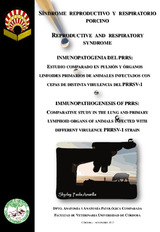Inmunopatogenia del PRRS: Estudio comparado en pulmón y órganos linfoides primarios de animales infectados con cepas de distintas virulencia del PRRSV-1
Immunopathogenesis of PRRS: comparative study in the lung and primary lymphoid organs of animals infected with different virulence PRRSV-1 strain
Autor
Amarilla, Shyrley P.
Director/es
Carrasco Otero, LibradoGómez-Laguna, J.
Salguero Bodes, Francisco Javier
Editor
Universidad de Córdoba, UCOPressFecha
2015Materia
PRRSVSíndrome reproductivo y respiratorio
Cerdos
Pulmones
Órganos linfoides primarios
Médula ósea
METS:
Mostrar el registro METSPREMIS:
Mostrar el registro PREMISMetadatos
Mostrar el registro completo del ítemResumen
El PRRSV es el causante del síndrome reproductivo y
respiratorio porcino; una enfermedad que, a pesar de los esfuerzos
realizados por controlarla y disminuir su impacto económico, sigue
siendo considerada como una de las enfermedades más importantes que
afectan al sector porcino.
Los dos genotipos del PRRSV, el genotipo Europeo o tipo 1
(PRRSV-1), representado por la cepa Lelystad (LV), y el genotipo
Norteamericano o tipo 2 (PRRSV-2), cuyo prototipo es el aislado
ATCC-VR-2332, presentan entre sí una elevada variabilidad genética y
biológica. Inicialmente, se creía que todas las cepas del genotipo
Europeo eran genéticamente homólogas. Sin embargo, el análisis de la
secuencia de la ORF5 y OFR7 han justificado la división del genotipo
Europeo en cuatro subtipos genéticos bien diferenciados: el subtipo 1 o
Pan-europeo, y los subtipos 2, 3 y 4 de Europa del Este.
La amplia variabilidad biológica, genética e incluso antigénica de
los diferentes aislados del PRRSV-1, así como las elevadas pérdidas
económicas que esta enfermedad ocasiona en el sector porcino, justifican
la realización de estudios que tengan como objetivo aclarar los
mecanismos patogénicos desencadenados por las diferentes cepas de este
virus. En esta tesis doctoral hemos evaluado la expresión del antígeno
viral, el cuadro lesional y la expresión de diferentes citoquinas proinflamatorias
e inmunomoduladoras en el pulmón y en los órganos
linfoides primarios (timo y médula ósea) tras la infección con una cepa... Porcine reproductive and respiratory syndrome virus (PRRSV) is
the causative agent of a disease of pigs, named porcine reproductive and
respiratory syndrome (PRRS). Despite efforts in controlling it and
reducing its economic impact, PRRS is still considered one of the most
important diseases affecting the swine industry.
PRRSV is divided into two distinct genotypes, European PRRSV
or Type 1 (PRRSV-1) with the prototype Lelystad strain (LV), and
North American or Type 2 (PRRSV-2), whose prototype is the ATCCVR-
2332 strain, with high genetic and biological diversity among both
genotypes. Initially, PRRSV-1 was thought to be genetically
homogenous. However, deep analysis of PRRSV-1 ORF5 and OFR7
sequences defined four distinct genetic subtypes: subtype 1 or Pan-
European, and subtypes 2, 3 and 4 in Eastern Europe.
The wide biological, genetic and antigenic diversity of the
different PRRSV-1 strains, as well as the high economic losses to the
pork industry associated with this disease justify studies that aim to
clarify the pathogenic mechanisms triggered by different virus strains. In
the present thesis we evaluated the expression of viral antigen, the
morphologic lesion and the expression of several proinflammatory and
immunomodulatory cytokines in lungs and primary lymphoid organs
(thymus and bone marrow) after the infection with a prototype PRRSV-1
Lelystad (LV), two field strains (SU1-bel, of high virulence, and 215-06,...

